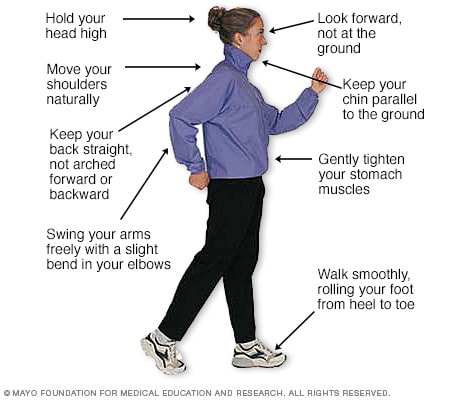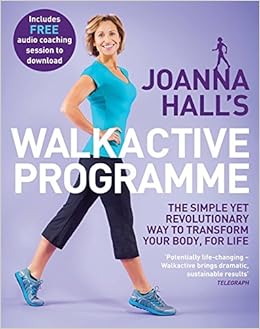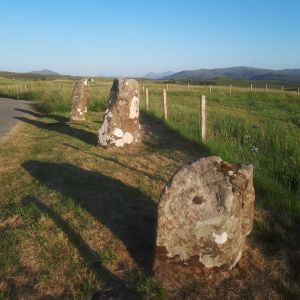A slightly longer post this month. So why should you bother to read on? Because it…
…tells you more about how and why I take my yoga ‘off the mat’
…could seriously improve your health and longevity
…summarises and points you in the direction of great resources to help you make positive, achievable changes in your own life
For local readers: I’ve put in a request at Portree Library for the books mentioned in this post (full details of all four books are at the foot of the post). There are already several copies of Hall’s Walkactive book available in Highland for borrowing, and the library is going to look into whether they can acquire copies of the other books.
********************************
The longer I do yoga, the more I ‘take it off the mat’ – i.e. connect it up with what I do in the rest of my life, outside of a yoga class setting. I think this is probably the case for all long-term yoga practitioners, and in fact some people (not me!) quickly make the ‘off mat’ connection when they’re pretty new to yoga. It’s also true of aspects of yoga which touch on emotional well-being, and values or philosophy of life, rather than physical self-awareness, alignment, etc. But in today’s post I’m going to focus in on the physical movement.
I mentioned in my last post, Daily Dose of Yoga, that despite having scoliosis and a history of back pain problems, I’ve found I can pretty much avoid back pain altogether as long as I do a bit of walking and yoga-type stretches and movements on a daily basis.
I used to walk loads: twelve years ago when everyone in the school I taught in was given a simple pedometer as part of Healthy Highland Week, I discovered I was clocking over 10,000 steps without thinking about it, every normal day of the week. But my walking reduced drastically when I moved out of the village (so instead of walking to work and the shops I had to drive), stopped primary teaching (which involves constant movement), got new dogs who need much less exercise than my first dog did, started working from home and at the computer, and began using most of my daily exercise time for yoga and pilates. The result, particularly in prolonged periods of bad weather and looming writing deadlines, was a daily step count which must have been under 3,000 most days.
Yoga and pilates have been great for me in so many ways – but doing only yoga and pilates (in classes or specific, time-limited practice sessions) is not enough for optimal health. Because it was particularly gruesome weather over Christmas 2016 and the whole family were lying about like slugs, I reached a tipping point where I could feel all the cells in my body screaming BRING BACK WALKING! The oft-cited 10,000 steps a day for health may be to an extent a rather arbitrary figure, but I reckon human beings are definitely meant to be walking more than most of us do. I mean, 6,000 steps is only the equivalent of spending one hour out of every 24 on your feet! I wanted to get moving again, so I clipped on a pedometer and got going. For several months in 2017 I aimed to get over 7,000 steps per day. I noted the daily tally in my yoga practice journal, and ended up averaging 9,000 a day. Just wearing the pedometer (or downloading a free pedometer app, if you’re the kind of person who always carries your smartphone) makes you more mindful of how much you’re moving and encourages you to walk more. My particular pedometer has a little figure who pops up, arms waving in cheerleader mode, when you hit 10,000 steps. This is just like the ‘rewards’ you get in maths computer games for 8 year olds so I find it amusing that I too feel chuffed every time I see the wee guy going ‘yaaaay!’ for me.
Any time I consistently wear a pedometer and aim to increase and record my daily step count, I notice within a few weeks I feel a bit fresher and more energetic, and also more physically tired, in a good way – I sleep better at nights. We don’t have scales in the house so I practically never weigh myself, but my trousers get a bit looser round my hips and thighs after a couple of weeks walking briskly and regularly. And if you’re reading this in the Hebrides, please know it made a huge difference to me when I finally invested in good quality waterproof trousers, cagoule, hat, gloves and footwear. If you wait for nice weather to go for a walk here, you’re rarely going to get that step count increased!
Walking matters, but so does how you walk. I’ve known for years I’m anatomically wonky, and that this has implications for my current musculoskeletal health and longer-term wear-and-tear. So I’ve done a bit of looking into how I can minimise the potential effects of my mild spinal curvature and lopsided hips.
The internationally-respected Mayo Clinic says ‘a fitness stride requires good posture and purposeful movements’:

If you want more information about this, and a few varied and detailed programmes for increasing the amount and pace at which you walk, and improving the style in which you walk, check out the work of Joanna Hall. When I loaned this book to my mum, I had to say ‘ignore the terrifyingly jolly cover – there’s good stuff inside’. And she agreed. So if you too find the relentlessly cheerful and ultra-slim author photographs off-putting – please give it a go anyway!

Image credit: amazon.co.uk
The first time I followed Hall’s walking technique tips, I was impressed and also quite surprised by what I learned. As a long-term yoga practitioner, I have better proprioception than many people, yet I was almost oblivious to three important aspects of how I was moving:
- I knew my feet and ankles are quite flexible, and I roll through my feet quite well when I walk. I knew my right foot is slightly larger than my left. And I’d felt, with all the yoga over the previous few years, my toes had been spreading and lengthening. But I hadn’t noticed my right toes were really squashed up in almost all the shoes I owned! I gave away lots of my shoes that year, and bought ones which fitted better.
- I knew I sashayed about a bit as I walked, but I’d never noticed that was because my poor wonky left hip was shoogling all over the place, so my left leg was going round and round like a porridge spurtle. I’m structurally lopsided so I can’t completely correct my gait, but becoming aware of this has led to me walking more mindfully and with better alignment.
- I had a mental image of myself striding along, arms swinging, because that is how I used to walk. The combination of walking a lot less and then in recent years mainly walking with a lead in one or both hands had gradually resulted in the top half of my body becoming almost motionless. A sort of Irish step dancing version of walking. It felt great to get my shoulder girdle moving again.
So – it was an education, and I can only say ‘thank you, Ms Hall’ because by paying attention and learning her techniques, I quickly felt more easy, smooth and energetic as I walked. I revisit her book regularly and some of the techniques suggested in it are almost second nature to me now.
In 2016, I also discovered the work of Katy Bowman. I’ve referenced two of Bowman’s books at the foot of this post, but if you prefer podcasts, a massive blog archive, or Instagram – Google her and you’ll find she has a very active online presence. I first read Whole Body Barefoot, on the recommendation of an excellent yoga teacher who I was training with. I’d noticed Joanna Hall recommended minimal shoes – wide toe boxes, flexible and not too thick soles, and flat – and I learned a lot more about why you might want to transition slowly to this type of footwear by reading Bowman’s book. I’m not going to say a lot about the book here other than when I talk about it in yoga classes, there’s always at least one person says ‘I always wear flat shoes, I never wear heels’ – without realising that the flat shoes or boots they’re wearing that day do in fact have heels. Have a look at your trainers and you might be surprised to find how much the heel is elevated relative to the front of the shoe! I’ve always mostly worn fairly wide and flat shoes and sandals, though many years ago, I used to have a thing for wearing ankle boots with heels to work (until even I in my ignorance noticed it was related to knee and toe pain I was experiencing). Over the last couple of years, I’ve gradually shifted to more genuinely flat (‘zero drop’) shoes and the only downside is my feet are so happy in them it’s become difficult to wear more ‘dressy’ alternatives.
Whole Body Barefoot is a short book which explains how the way we treat our feet impacts on…well, everything to do with posture, alignment and gait. Which can have negative consequences in terms of knee, hip or back pain. There are also great foot, calf, hamstring and balance exercises which you’ll probably recognise from yoga classes. Bowman is a biomechanics and natural movement expert, not a yoga teacher, but a lot of what she recommends chimes well with movements made in yoga. Squats, for example. She’s very keen on squatting. There’s a lot more about squatting, other movements, and other research in her much larger book, Move Your DNA (which also includes the exercises which feature in the much shorter Whole Body Barefoot). Don’t be put off by the size of Move Your DNA, because Bowman has a very readable style. I do find the strength of her convictions occasionally lead to her over-reaching the evidence for some of her claims, but despite this, there’s lots of great stuff in Move Your DNA including a more extensive programme of exercises, many of which you’ll recognise from yoga. She’s also passionate about and good at suggesting ways of building a wider range of healthy natural movement into your normal day-to-day activities, rather than sitting for hours then trying to find the time in a busy life to squeeze in separate sessions of ‘exercise’ such as a fitness class or gym session.
The final book on my list, Designed to Move by Joan Vernikos, was actually recommended by Bowman in a December article suggesting movement-related Christmas gifts to her email subscribers. Dr Vernikos was director of NASA’s Life Sciences Division and a pioneer researcher in the physiology of immobility (investigating how lack of movement in gravity affects astronauts and those on Earth who are immobile, e.g. in bed-rest studies). To summarise, space research into astronaut health discovered that ‘Physiological changes in highly fit astronauts in the near-zero gravity of space, or those caused in healthy men and women by continuous sitting or lying in bed, are similar to those in the elderly’. There’s a two page table of the sort of changes they mean – you can probably guess some of them – decreased muscle mass, arterial stiffness, decreased brain blood flow, slower movement and reaction times, increased body fat, lower bone density….etc. etc.
This is a small book and the first 80 pages or so are dedicated to explaining the research and evidence which underpins the message that sitting still for hours a day is seriously bad for human beings. Even if you also do an hour’s vigorous exercise a day, this doesn’t counter the negative effects of long periods sitting still. Whereas, building in some simple changes of habit – even as simple as standing up every half hour for a minute of stretching tall or walking around, then sitting back down again – can have a huge positive impact on your health and well-being over the longer term. The remainder of the book, pp85-111, focuses on these simple activities, habits and movements which you can build into your life to counter the pernicious effects of sitting still for long periods (at your work desk, in the car, on the sofa in front of the TV, etc.).
Although it’s a slim book, I feel it could have been slimmer with the work of a good editor. It is well-written in that the grammar, spelling and so on are fine, and it’s a clear read. However, there is a lot of repetition, which I found quite irritating. It’s as if Vernikos has delivered her profound, evidence-based yet essentially simple message so many times that she’s lost sight of whether’s she’s explaining things in the right order and whether she’s repeating herself within this one book – and no editor has dealt with it. To take one example, the exact same University sit-&-rise-from-a-chair test (which is really interesting, and fun to do!) is described twice, once on p54 then again on p85. There’s also a diagram on p9 using terms such as Gz and Gx, but these gravity science terms aren’t properly explained until pp61-62. And lots of repetition of the advice to GET UP OUT YOUR CHAIR AT LEAST EVERY HALF HOUR. I guess it must be very frustrating to know there’s this simple thing which people can do to make themselves healthier and happier, but they’re just not doing it… Despite this, I do recommend you read through the whole book – and probably read from p85 until the end a couple of times, noting down any and all of her tips which you could build into your daily life. It takes time to make even simple changes, so it might be worth pinning a short list of moves as a reminder in the places you need them – such as by the TV or computer screen.
If you’ve got this far, congratulations! And also, it’s time for you to stand up and move 😉 I hope I’ve inspired you to look into these resources a little more. Or even if you don’t want to read more about it – simply to time your sitting, to ensure you stand up and move a little every half hour. Or next time you arrive early at my yoga classes, get out of your car and go for a short walk – it’s a great warm up for yoga, and so much nicer for your body than sitting for even longer in the driving seat.
If you’ll excuse me, I’ve got to stand up to do another stretch and squat break now…
Books reviewed in this post – ask at Portree Library if they are on the shelves yet, and if not, you can borrow mine!
- Katy Bowman, ‘Move Your DNA: Restore Your Health Through Natural Movement’, Lotus, 2014.
- Katy Bowman, ‘Whole Body Barefoot: Transitioning Well To Minimal Footwear’, Propriometrics Press, 2015.
- Joanna Hall, ‘Walkactive Programme: The Simple Yet Revolutionary Way To Transform Your Body, For Life’, Piatkus, 2013.
- Joan Vernikos, ‘Designed To Move: The Science-backed Program To Fight Sitting Disease & Enjoy Lifelong Health’, Quill Driver Books 2016











